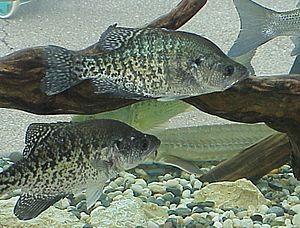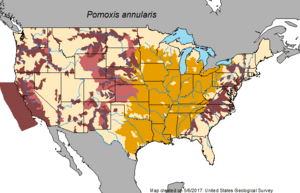White crappie facts for kids
Quick facts for kids White crappie |
|
|---|---|
 |
|
| Conservation status | |
| Scientific classification | |
 |
|
| Distribution map of the white crappie. Yellow represents native and purple represents where it has been introduced. |
The white crappie (its scientific name is Pomoxis annularis) is a type of freshwater fish. You can find it in North America. It's one of two kinds of crappie fish. People sometimes call it the goldring or silver perch. Even a ship, the USS Goldring, was named after this fish!
The name Pomoxis comes from the crappie's sharp gill cover. The name annularis means 'having rings'. This refers to the faint vertical stripes you can see on the fish's body.
Contents
What Does a White Crappie Look Like?
White crappies look a lot like black crappies. But there are some key differences! White crappies have 5 to 10 dark vertical stripes on their sides. Black crappies have scattered spots instead.
This fish is usually silvery. It might have green or brown colors on its back. Its belly is white. The dorsal fin (the one on its back) starts further back on the body than on a black crappie. The anal fin (the one on its belly) is about the same size.
A white crappie has six spines in its dorsal fin. Black crappies have seven or eight. White crappies are also a bit longer and flatter than black crappies. Their body depth is about one-third of their total length.
White crappies have special fish scales called ctenoid scales. These scales have tiny tooth-like bumps on them. Both types of crappies have a mouth at the very front of their head. They have many small, cone-shaped teeth in two rows. These teeth are called cardiform because they look like tools used for wool carding. Crappies belong to the fish family Centrarchidae.
A white crappie rarely weighs more than 2 pounds (0.91 kg). They usually live for 2 to 7 years. Most adult white crappies are about 9–10 inches (23–25 cm) long. The biggest white crappie ever caught weighed 2.35 kg (5.2 lb)!
Where Do White Crappies Live?
White crappies are originally from the Great Lakes, Hudson Bay, and the Mississippi River areas. Their native home stretches from New York and southern Ontario all the way to South Dakota and down to Texas.
This fish lives in many parts of the United States. Its population is currently stable. Because of this, it is listed as a least concern species for conservation. This means it's not currently at risk of disappearing.
White Crappie Homes and Habitats
You can find white crappies in large rivers, reservoirs, and lakes. They can handle murky (turbid) water better than black crappies. In murky waters or places with few water plants, white crappies are often more common than black crappies.
They are most often found in rivers and slow-moving areas. This includes quiet pools and backwaters of rivers. They are most common in lakes and reservoirs larger than 5 acres. White crappies swim in open water during mornings and evenings. But during the day, they prefer shallower, calm waters. These spots are usually 6–12 feet (1.8–3.7 m) deep and have structures like logs or rocks nearby.
White Crappie Reproduction and Life Cycle
White crappies lay their eggs in May and June. This happens when the water temperature reaches about 56 °F. The male crappies build nests. They make small, bowl-shaped dips on the bottom of the water. They build these nests around brushes, rocks, and logs in shallow areas.
During this time, male crappies get dark colors on their throats. Females can lay a lot of eggs, from 5,000 to 30,000! The males then guard these nests until the baby fish (called fry) swim away. Males protect the nests to help make sure their genes are passed on to the next generation.
Baby white crappies usually grow 3–5 inches (7.6–12.7 cm) in their first year. They can grow another 3 to 4 in in their second year. White crappies become adults around their second or third year. They can live for 8 to 10 years, but on average, they live 3 to 4 years in wild waters and up to 6 years in managed areas.
What Do White Crappies Eat?
White crappies don't just swim around looking for food all the time. They also don't hide and then suddenly attack their prey. Instead, they swim a little, then stop and look for food. This is called a "pause-and-travel" search strategy. This way of hunting helps young crappies grow fast. It also saves energy because they don't have to search for food constantly.
When they are very young (larval and juvenile stages), white crappies eat zooplankton. These are tiny animals that float in the water. They continue to eat small invertebrates (animals without backbones) during their first year.
When white crappies grow to about 12–15 centimetres (4.7–5.9 in) long, they are considered adults. Adult white crappies mainly eat small fish. This includes minnows and young American shad. They also eat larger invertebrates like crayfish and hellgrammites. What they eat can change depending on where they live.
They eat the most from June through October. In the spring, they eat a moderate amount. Their feeding slows down during the winter months. For example, in Mississippi, they eat mayflies. In Illinois, they often eat American gizzard shad. In Pennsylvania and Ohio, adult crappies eat small common carp, yellow perch, bluegill, and even other white crappies! Their mouth position at the front of their head allows them to easily eat what is right in front of them.
Images for kids




